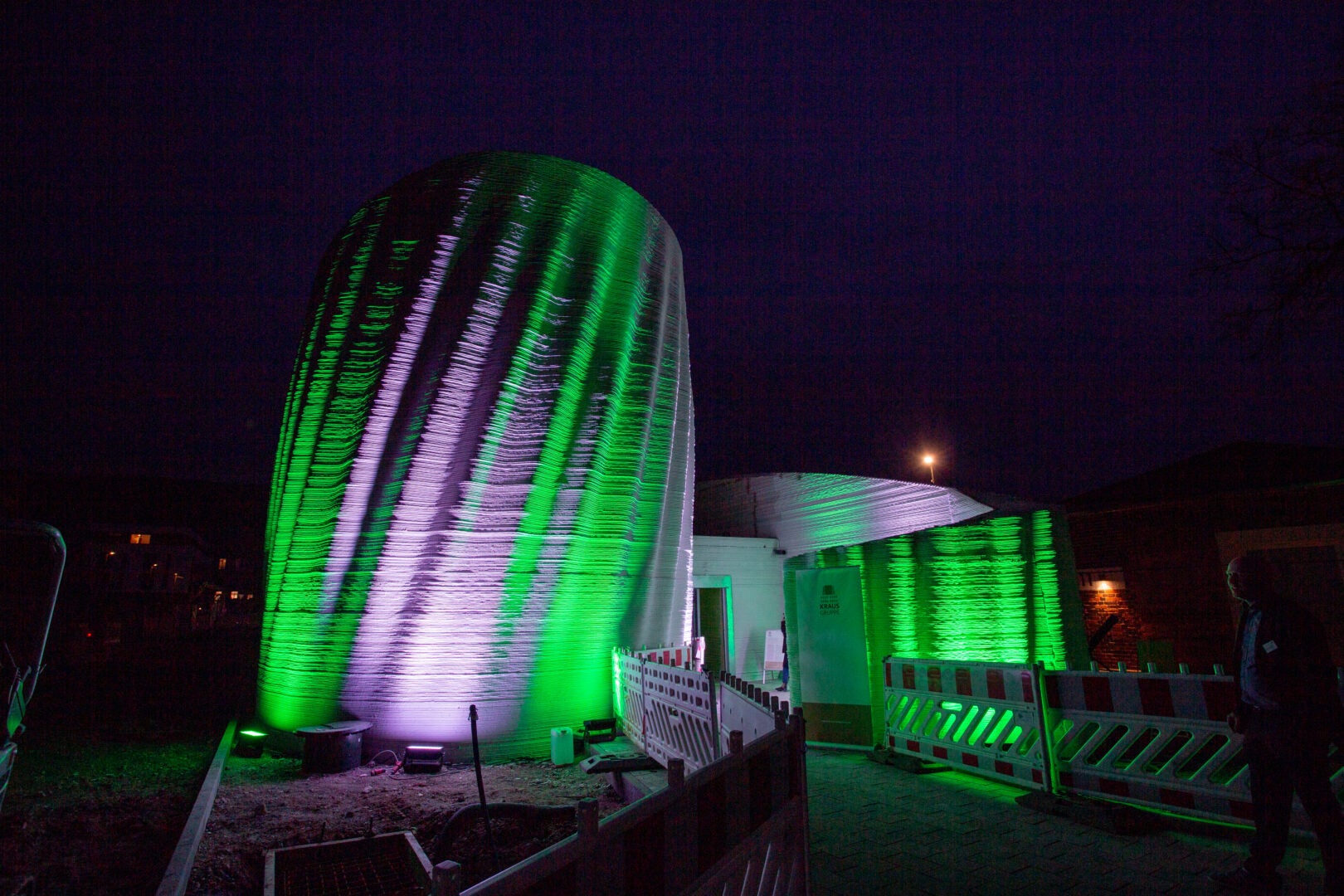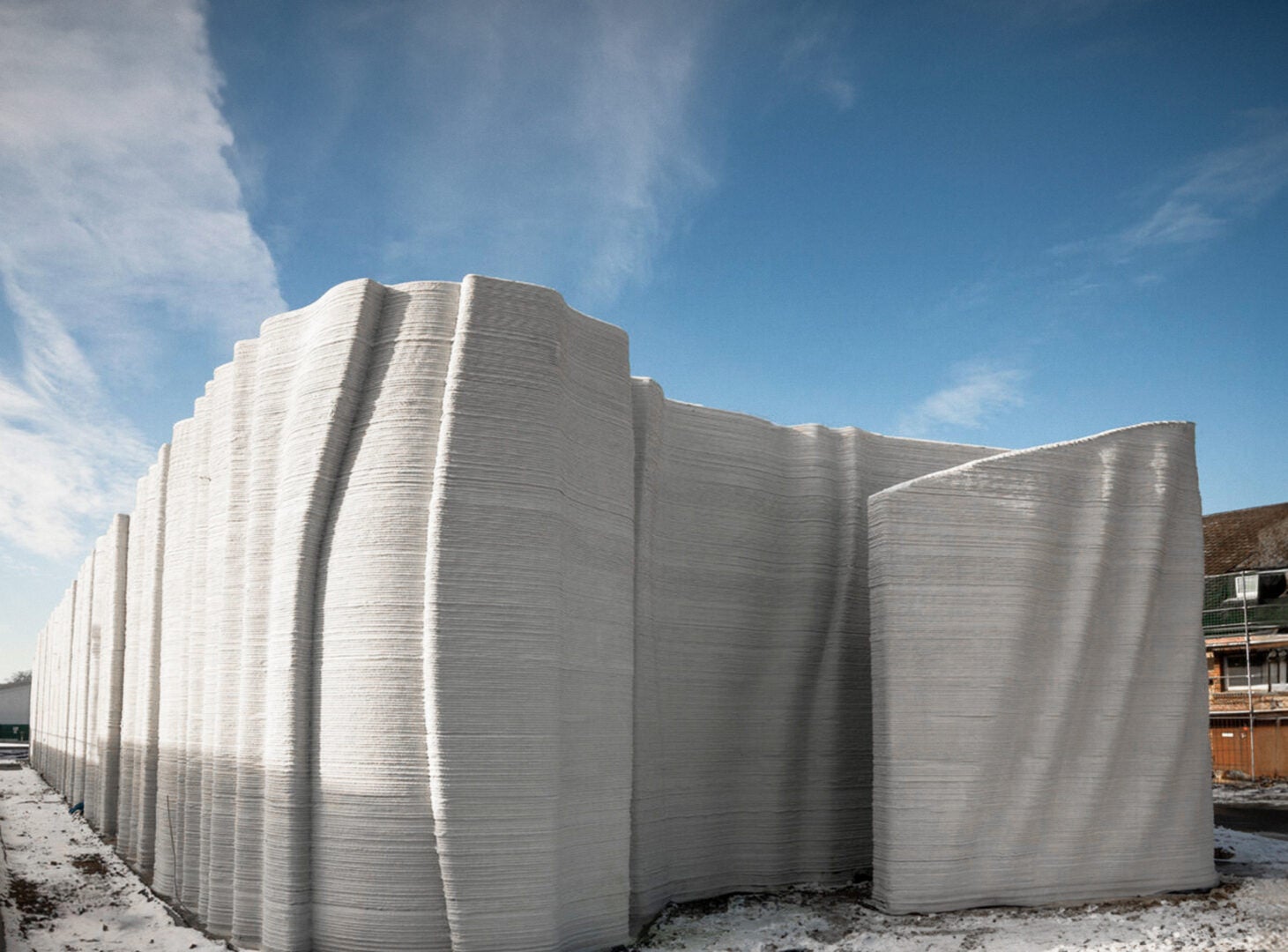- The city of Heidelberg, PERI 3D Construction and KRAUSGRUPPE has inaugurated The Wave House – a data center in Heidelberg and the largest 3D printed building in Europe so far, marking a significant advancement in the construction industry.
- Despite the typical absence of large windows and openings in data centers, an aesthetically pleasing and interesting building has been designed by architects SSV and Mense Korte through the incorporation of wave-designed walls, which could only be made with 3D construction printing technology.
- Utilizing the BOD2 printer from COBOD International PERI completed walls at a rate of 4 square meters per hour over a total area of 600 m2 (6.600 SF).

Heidelberg, Germany – February 2024 – In a landmark achievement for the 3D construction printing industry, PERI 3D Construction announces the completion of Europe’s largest 3D printed building, the Wave House data center in Heidelberg, Germany. The building is also one of the first and globally largest industrial buildings made with the 3D construction printing technology.
At the opening ceremony a few weeks ago the realization of the project was celebrated with the handover of keys to the new occupants, IT Heidelberg, in the presence of project partners, the mayor, and a wide array of media representatives.
Due to the typical absence of windows and large openings in all or the main areas of data centers, for safety and other reasons, data centers tend to look quite dull and uninspiring. As long as such data centers are placed far outside the cities this problem is perhaps of less concern, but the trend towards making data centers more in the vicinity of the users and therefore locate them in suburban areas and cities has created a need to make the data centers more visually appealing.
A challenge that in the Heidelberg project was solved by the architects SSV and Mense Korte by giving the walls a wave design, a design feature that also gave name to the building: The Wave House. Such wave designed walls could not have been realized using conventional construction methods, so Instead 3D construction printing technology was used due to the design freedom of this construction method.
At the hand over event Dr Fabian Meyer-Brötz, managing director of PERI 3D Construction commented on the project. ” We are very proud to have realized our largest building to date with this project. Not only because of the size of it, but in particular due to the special shape and the parametric design used, which documents the immense design freedom of COBOD’s technology”.
The building’s measurements – spanning 600 m2 (approximately 6,600 SF), with dimensions of 54m (177 ft) in length, 11m (36 ft) in width, and 9m (30 ft) in height – were achieved with the walls printed in a just 140 hours. This equates to an efficiency rate of 4 square meters per hour, underscoring the fast execution time of the 3D construction printing technology.
Hans-Jörg Kraus, managing partner of KRAUS GRUPPE Heidelberg, also commented on the cost-efficiency achieved through 3D construction printing: “I cannot tell you what it would cost if we had made the data center conventionally. 3D construction printing made this project economically viable”.

Henrik Lund-Nielsen, Founder and General Manager of COBOD International, shared his excitement: “This data center stands as a testament to the advanced capabilities of COBOD’s technology, demonstrating our technology’s’ possibility of delivering not just residential buildings, but also multi-story buildings and complex structures including office spaces, warehouses, and data centers”.

ABOUT COBOD INTERNATIONAL
We are the world leader in 3D construction printing solutions with +65 printers sold world-wide.
COBOD’s mission is to build smarter through multifunctional construction robots based on 3Dprinting technology and COBOD’s vision is to automate a minimum of 50% of construction processes on building sites. All leading to better, faster, cheaper and more sustainable construction than conventional concrete. We constantly strive to reduce the co2 footprint of 3D printed concrete.
COBOD’s 3D printers made Europe’s first building in 2017. Subsequently our printers made the first 2- and 3-story buildings in Europe (Belgium & Germany), North America (US & Canada) and India. Also, the first 3D printed villa in Dubai and buildings in Africa have been done by COBOD 3D construction printers, just like the first wind turbine bases.
COBOD has an open-source material strategy, partnering with customers, academic institutions, and suppliers around the world.
COBOD is privately owned by General Electric, CEMEX, Holcim and PERI as key shareholders, and our partners further include Dar Al Arkan (Saudi Arabia), L&T Construction (India), JGC (Japan), Siam Cement (Thailand) and Orascom (Egypt).
COBOD is headquartered in Denmark with regional offices and competence centers in Florida and Malaysia. Our team consists of +100 passionate pioneers from 25 nationalities and through our installed base of printers, we have a truly global presence in North- and Latin America, Europe, the Middle East, Africa, and Asia-Pacific.
ABOUT PERI GROUP
Founded in 1969, PERI is the world’s leading manufacturer and supplier of formwork and scaffolding systems. In 2018 PERI Group acquired a minority stake in COBOD. Since then, both companies have worked closely together and pushed the boundaries of 3D construction printing. In 2020, using a COBOD BOD 2, PERI realized the first 3D-printed residential building in Germany and the biggest printed apartment building in Europe.
